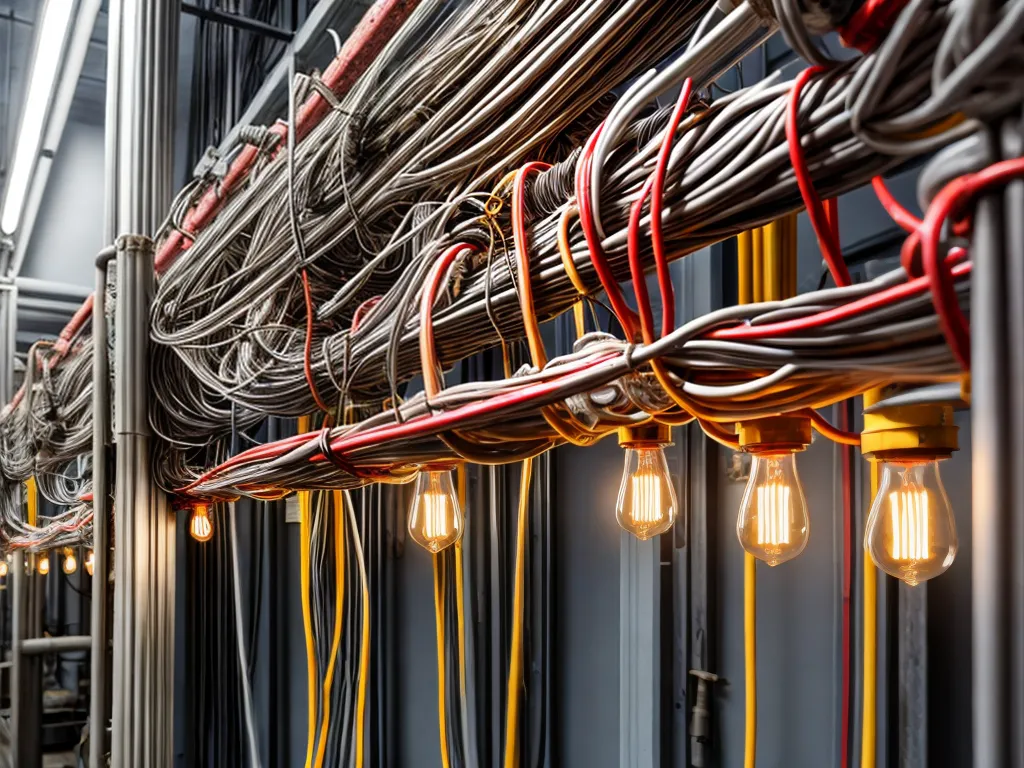
Industrial electrical work can be complex and dangerous if proper protocols and safety measures are not followed. As an electrician working in industrial settings, I have seen some common wiring mistakes that can cause major problems down the line. In this article, I will highlight some of these key errors and provide tips on how to avoid them.
Improper Wire Sizing
One of the most frequent issues I encounter is improper wire sizing. Industrial facilities have high power demands, so the wires must be large enough to handle the expected loads. Undersized wiring can lead to overheating, voltage drops, tripped breakers, and even fires.
To avoid this:
- Carefully calculate the amperage rating needed based on the connected equipment loads and future expansion plans
- Use wiring at least one size larger than the minimum required - this provides headroom and reduces voltage drop
- Consult wire sizing charts to select the proper gauge for long runs
Pay particular attention to the wires for large motors, heavy machinery, HVAC systems, and other high-draw equipment. Oversizing the wires is better than undersizing in industrial applications.
Inadequate Wiring Protection
Industrial settings have more physical hazards that can damage exposed wiring compared to residential buildings. I often see wiring runs that lack proper enclosures, conduit, strain relief, or abrasion protection. This leaves the conductors vulnerable to:**
- Impacts from forklifts, moving equipment, etc.
- Crushing at cable entry points
- Cutting from sharp metal edges
- Vibration damage from operating machinery
To avoid wiring damage:
- Use thick-walled conduit and metal raceways to protect cables
- Provide extra slack at connection points to avoid pull stress
- Use abrasion-resistant cable jackets if wires could rub
- Support long vertical runs so they do not put tension on terminations
Take the operating environment into account and protect all wiring from foreseeable damage.
Wrong Wire Terminations
Faulty terminations account for a surprising number of wiring problems I find. Using the wrong style or size of lug, insufficient torque, no strain relief, or shoddy workmanship can all cause high resistance connections. This leads to overheating, arcing, and loose wires.
When terminating industrial wiring:
- Select lugs rated for the wire size and material
- Follow manufacturer torque specs for tightening lugs
- Allow some cable play to avoid tension on lugs
- Use two wrenches to prevent spinning when tightening
- Ensure wires are fully inserted and securly gripped
Take the time to properly terminate all cables and confirm they are tight, aligned, and tension-free.
Mixing Wiring Types
Industrial facilities often have different wiring systems that get interconnected. For example, you may need to connect solid building wiring to flexible cords feeding equipment. Mixing different wire types improperly can create safety hazards:
- Solid and stranded wires terminated under the same lug can vibrate loose
- Cords and cables made of different metals can corrode when in contact
- Mismatched insulation types can chafe and expose live conductors
When interfacing wiring:
- Use the correct connectors and lugs for each wire or cable type
- Isolate dissimilar metals like copper and aluminum
- Avoid grouping incompatible insulations together
- Secure cords feeding equipment to reduce vibration strain
Be mindful of wiring compatibility issues and potential problems when integrating multiple systems.
Incorrect Breaker Sizing
Another issue I frequently catch during industrial panel inspections is incorrect circuit breaker sizing. If the breaker is undersized, it will nuisance trip or fail to protect the wiring. Oversized breakers won't trip when they should and can allow damage or fire.
To size breakers properly:
- Match breaker amp rating to wire size based on NEC guidelines
- Understand permitted sizing tolerances like 125% rule for motors
- Consider ambient temperature deratings for hot environments
- Select "C" curve breakers for lighting and "D" curve for motors
- Allow room for future load increases when possible
Take the time to analyze all connected loads and choose the right breaker for each circuit. Don't rely on guessing or old breaker values without verification.
Neglecting Labels and Warnings
The last key issue I often find is a lack of adequate labels, markings, and warnings. Industrial wiring systems are complex, so identifying cables, panels, switches, and junction points is crucial. Warning signs are also needed to alert people to potential arc flash hazards and high voltage risks.
To avoid confusion and danger:
- Clearly label all wire junction boxes and mark wire runs
- Post updated panel schedules documenting all breakers
- Apply hazard stickers on high voltage panels and disconnects
- Use large warning signs near arc flash risks and safety hazards
Proper identification and warnings help ensure a safer, more organized electrical system.
By being mindful of these common wiring pitfalls, industrial electricians can avoid problems down the road. Let safety and workmanship be your priorities. Following the best practices outlined above will lead to more reliable power systems and help prevent fires, injuries, and downtime.